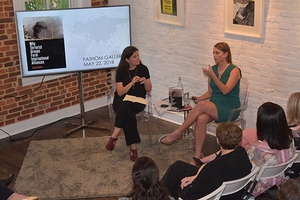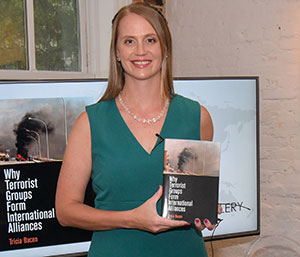Research
New Book Examines How Terrorist Groups Become Allies

A new book, Why Terrorist Groups Form International Alliances, by AU School of Public Affairs Assistant Professor Tricia Bacon, examines why some terrorist groups choose to work together, and how policymakers can disrupt them.
The book reviews partnerships formed by the Popular Front for the Liberation of Palestine, Al-Qaida, Egyptian jihadist groups, and others. Bacon looks into the benefits of partnering (bolstering operational effectiveness, efficiency, and prestige) and potential risks (exposing partners to infiltration, security breaches, and additional counterterrorism attention).
Conventional wisdom says that shared ideas and ideologies motivate groups to form alliances. According to Bacon, however, shared enemies and common ideologies do not cause alliances to form. Rather, they create affinity to bind partners and guide partner selection.
Bacon argues that terrorist groups actually face substantial hurdles when attempting to ally and, when alliances do form, they are not evenly distributed across pairs. Instead, she demonstrates that when terrorist groups seek allies to obtain new skills, knowledge, or capacities for resource acquisition and mobilization, only a few groups have the ability to provide needed training, safe haven, infrastructure, or cachet. Consequently, these select few emerge as preferable partners and become hubs around which other groups cluster.
Although it is not easy for terrorist groups to form alliances, Bacon says that once formalized, they do last, and those tight networks have been central to the continuing strength of Al-Qaida and ISIS. The takeaway for policymakers: disrupt alliances at an early point, when they are most vulnerable.
"The importance of alliances has come into focus again as ISIS has experienced military setbacks. Like Al-Qaida before it, ISIS has a network of allies that it can turn to for assistance to sustain its position," says Bacon. "We see a repeat of this cycle where allies can really step in during these periods of weakness. These findings were borne out again with ISIS."
Once groups cluster and ally with hubs, they tend to become the most violent and resilient and pose the largest threat.

"Groups look to form these alliances when they are organizationally weak in terms of their skills, knowledge or ability to mobilize resources. They experience these problems and they can't address them on their own," writes Bacon. "Rather than being a sign of strength, it's fundamentally a sign of weakness."
On May 22, Bacon's book was the focus of an SPA event moderated by Georgetown University's Elizabeth Arsenault, an expert on terrorism, torture, and interrogation.
"Formation of trust between groups and early cooperation is key to forming an alliance," said Bacon during the event. "If we can stop this from happening early on, then this prevents alliances in the future."
This book emerged from Bacon's early research and experience working in the intelligence community in the early 2000s, monitoring terrorist groups in North Africa. When she realized there was not published research on why groups partner, she made the question the subject of her academic research. The research has continued relevance in North Africa since it is a place where there is both an Al-Qaida ally and an ISIS ally jockeying for position, which is contributing to violence there, says Bacon.
